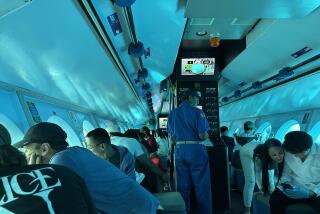Mini-Sub Gives First Peek Inside Sunken Arizona
- Share via
PEARL HARBOR, Hawaii — A miniature, remotely operated submarine has given researchers their first look ever inside the sunken battleship Arizona.
The 8-pound device was lowered into the waters of Pearl Harbor on Thursday in a test run by divers and researchers from the National Park Service, its Canadian counterpart, universities and the Army and Navy.
The team is trying to figure out how much longer the Arizona will hold back whatever remains of the more than 1 million gallons of fuel oil that went down with it during Japan’s Dec. 7, 1941, attack on Pearl Harbor.
The attack killed 1,177 sailors from the Arizona, about 900 of whom are entombed in the ship in 40-foot-deep waters.
“It’s not an enormous undertaking to cut into a ship and pump out oil,” said Larry Johnson, chief of the National Park Service’s Submerged Cultural Resources Unit, based in Santa Fe, N.M. “But we have to be respectful that this is a war grave and a war memorial. That’s why this particular site creates such a complex problem.”
The mini-sub is fitted with an ultrasonic gauge designed to measure the thickness of the Arizona’s metal.
It was used in September to scout the ship’s exterior for National Geographic, the Discovery Channel and the History Channel.
In Thursday’s expedition, the device beamed back images from an aft bathroom, where a tube of toothpaste still sat in a cup.
The mini-sub has not detected signs of human remains. Officials from the Park Service, which oversees the USS Arizona Memorial, say they probably have decomposed.
Only a few divers certified through the Park Service are even allowed to be on the outside of the ship.
Those divers drop 30 feet down what’s left of gun turret No. 4 to deposit the remains of Arizona sailors who survived the 1941 attack and later wished to be buried with their shipmates.
The study of the Arizona’s structural stability is led by Donald Johnson, a professor emeritus from the University of Nebraska-Lincoln.
Other researchers are studying the microbial community that surrounds the Arizona.
The Pennsylvania firm VideoRay offered the use of its technology and one of its $11,500 mini-subs, which are normally used to inspect water tanks and oil rigs.
More to Read
Sign up for Essential California
The most important California stories and recommendations in your inbox every morning.
You may occasionally receive promotional content from the Los Angeles Times.













